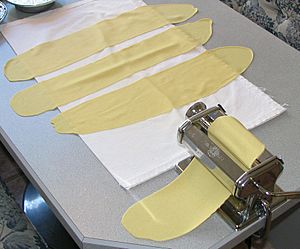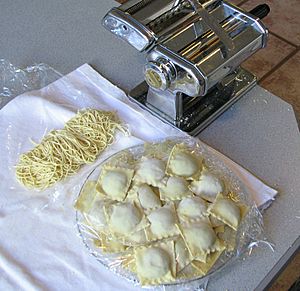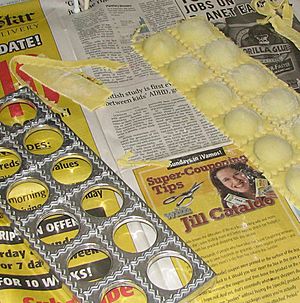Alkaline noodles facts for kids

Alkaline pasta being rolled out on an Italian pasta machine
|
|
| Main ingredients | Durum wheat, flour, alkali |
|---|---|
Alkaline noodles, also called alkali noodles or alkaline pasta, are a special type of noodles. They have a lot more alkali in them than regular noodles. Two well-known examples are Chinese Lamian noodles and Japanese Ramen noodles.
Adding alkali changes how the noodles taste and feel. They become slippery and have a yellowish color. They are also more stretchy than normal noodles. You can make them with different kinds of flour, like regular white flour or semolina flour. The yellow color comes from natural substances in flour called flavones. These substances are usually clear, but they turn yellow when they mix with alkali.
Contents
How Alkaline Noodles Get Their Alkali
Noodles become alkaline by adding sodium carbonate (which is a type of salt) to the ingredients. In some parts of China, people traditionally use alkaline water from wells to make these noodles.
More often, a special mix is added to the dough. This mix is usually 20% sodium carbonate and 80% potassium carbonate dissolved in water. The Chinese call this mixture jian or jian shui. In Japan, it's known as kansui. Sometimes, kansui can also be a solution of sodium hydroxide or a powder mix of different carbonates and phosphates.
Special Alkali for Chinese Noodles
Some Chinese noodles, like the chewy "hand-pulled" Lamian noodles from Gansu Province, use a special alkali called peng hui. Traditionally, peng hui comes from the ash of a plant called Halogeton arachnoideus. This traditional peng hui contains potash (potassium carbonate). It helps make the noodle dough softer and more tender. It does this by stopping gluten from developing too much.
In 1989, scientists created an artificial peng hui. It's a mix of salt, sodium carbonate, sodium tripolyphosphate, and Sodium Metabisulfite. "Lanzhou pulled noodles" are very famous. Even if the noodle makers are not from Lanzhou, the capital of Gansu, the name means the noodles are delicious.
Making Alkaline Noodles at Home
You can even make alkaline noodles at home! A famous food scientist named Harold McGee shared a simple way. He learned from chefs like David Chang and Fuchsia Dunlop. You can bake regular baking soda (sodium bicarbonate) in the oven at 300°F (150°C) for an hour.
When you bake baking soda, it releases water vapor and carbon dioxide gas. What's left is sodium carbonate, which is alkaline. You only need a tiny bit of this baked baking soda for your pasta dough. For example, just 1 teaspoon for 1-1/2 cups of semolina flour. First, dissolve the sodium carbonate in a little water. Then, slowly add this water to the flour. After kneading the dough, let it rest for an hour. Then, you can roll it out very thin with a pasta machine and cut it into your favorite noodle shapes.
See also
 In Spanish: Kansui para niños
In Spanish: Kansui para niños



